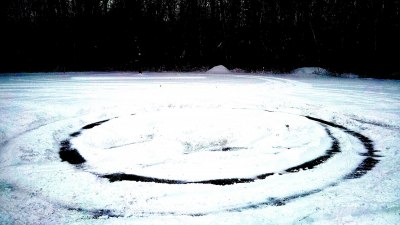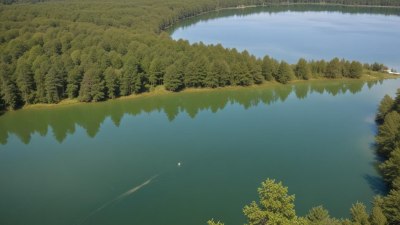What Causes Ice Disks to Spin on Rivers The Strange Winter Phenomenon
Explore the intriguing science behind spinning ice disks on rivers and their fascinating formation during winter.

Ice disks, also known as ice circles, are a captivating natural phenomenon that can occur in rivers and other bodies of water during the winter months. These smooth, disc-shaped formations of ice spin slowly in the river's current, creating a stunning visual display that has intrigued observers for generations. In this article, we will delve into the causes of ice disks, how they form, and the conditions that favor their creation. By exploring the science behind these fascinating structures, we can appreciate the complexities and beauty of nature.
Understanding Ice Disks
Ice disks are typically circular and flat, resembling a giant frisbee or a round skating rink. They vary in size, with some being just a few feet in diameter, while others can stretch up to 50 feet or more. Although their spinning motion can appear random, there are specific physical forces at play behind the phenomenon.
The Science of Formation
The formation of ice disks is largely due to a combination of environmental factors and the natural dynamics of water flow. Most notably, ice disks form in slower-moving sections of rivers, especially in areas where the current is gentle and the water temperature is sufficiently low for freezing to occur.
One key factor in the formation of ice disks is the presence of a central point around which the ice can form. This might be a small obstruction in the river, such as a rock or a branch, that disrupts the flow of water and creates an eddy. The eddy serves as a pivot point, allowing ice to accumulate and eventually form the circular shape that characterizes ice disks.
Temperature and Ice Thickness
The temperature of the water and the air plays a crucial role in the formation of ice disks. Ice disks are more likely to form when the air temperature is at or below freezing, causing the water's surface to freeze. When the ice begins to form, it is often not uniformly distributed. Instead, the turbulence caused by the eddy can lead to uneven thickness in the ice. Thinner areas may break off or flow at different speeds compared to thicker areas, which can enhance the spinning motion of the disk.
The Role of Water Current
The water current in which ice disks are formed is another crucial factor. In order for an ice disk to start spinning, there must be an existing current that can push against the edges of the ice. The difference in flow between the center of the disk and the edges is what typically leads to the rotation. A gentle current that circulates around the disk encourages it to spin, which can be further amplified as the ice breaks free from its initial formation point.
Environmental Conditions
Specific environmental conditions contribute to ice disk formation. Regions with cold winters and calm rivers are more likely to witness these phenomena. Ice disks have been observed in various places across the globe but are particularly common in North America and northern Europe. Some famous locations for observing ice disks include the Presumpscot River in Maine and the St. Lawrence River in Canada.
Local topography can also influence the water flow, creating the ideal conditions for ice disks to form. In particular, areas where riverbanks curve or where the current slows down can create eddies conducive to ice circle formation.
Culture and Folklore
Ice disks have not only scientific significance but cultural importance as well. Throughout history, various folklore and legends have emerged surrounding ice disks. Native American tribes, for example, have long revered these natural wonders, incorporating them into their stories and beliefs. Some associate these spinning disks with messages from the spirits, while others see them as signs of good luck.
Natural Variation and Observations
The size and behavior of ice disks can vary significantly based on local conditions. While some disks may rotate steadily, others may not spin at all due to insufficient current or uneven weight distribution. Occasionally, ice disks may even collide with one another, merging into larger formations as they drift together.
Ice disks can act as indicators of ongoing environmental changes as well. Their presence can signal shifts in river flow patterns or temperature changes, which are of interest to scientists studying climate trends.
Scientific Research
Researchers have taken an interest in ice disks due to their unique characteristics. Studies analyze the conditions that lead to their formation and the physical forces acting on them. Understanding these mechanisms contributes to a broader comprehension of fluid dynamics and thermodynamics in natural settings. Researchers utilize modern technology, including drones and sensors, to observe and measure the properties of ice disks in real-time.
Similar Phenomena
Although ice disks are spectacular, they are not the only winter phenomenon witnessed in frozen rivers. Other forms of ice formations include ice jams, frazil ice, and ice boulders. Each represents unique interactions between water flow, temperature, and respiration of the river system.
Environmental Impact and Conservation
The appearance of ice disks can serve as a reminder of the delicate balance effects humans have on waterways and local ecosystems. Activities such as logging, urban development, and water management can alter river dynamics, potentially impacting ice disk formation. Maintaining natural water flow is vital for preserving these exciting natural occurrences.
Conclusion
Ice disks are an extraordinary winter phenomenon that showcases the unique interplay between temperature, water currents, and natural obstructions. Their spinning motion and distinctive formation raise scientific inquiries and cultural interests alike. As we continue to observe and study these ice formations, understanding their mechanisms will deepen our appreciation for the natural world and the intricate processes that govern it.











